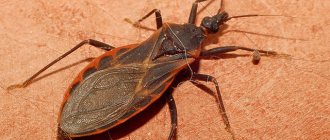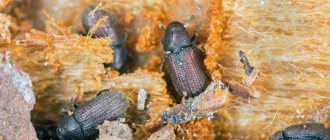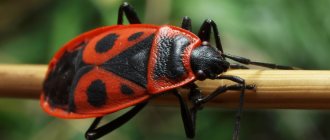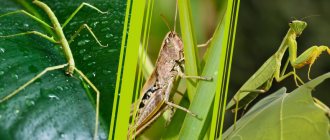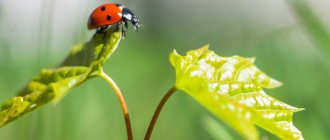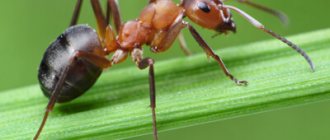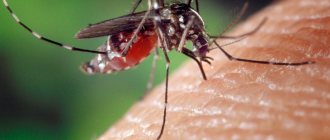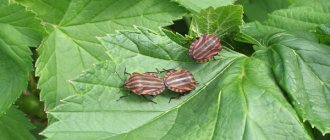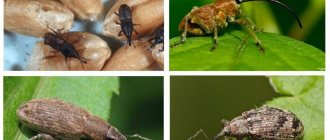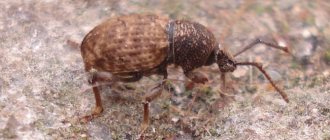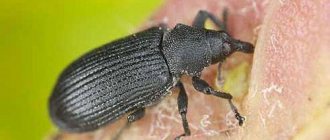Weevil
Weevils (or elephant weevils) are one of the most widespread families of beetles on the planet, with more than 50 thousand species. About five thousand of them are found in Russia. They got their name due to their characteristic appearance: the front part of the head of weevils is elongated, it is called the rostrum.
Gardeners and gardeners are well acquainted with these beetles - this pest is capable of not only spoiling the crop, but also completely destroying it. By the name of the species, you can understand what crop the beetle “specializes” in (for example, the beet weevil, a beet pest). The number of beet weevils is influenced by larger animals and birds. Shrews, hedgehogs, starlings, jackdaws and magpies, hoodies, jays, gulls, larks, quails and others feed on them.
Acorn weevils (oak fruit weevils) use oak fruits to breed offspring. The female makes a deep hole in the immature acorns and lays one or two eggs there. After about two weeks, yellowish-white larvae with a red-brown head appear.
Poisonous spiders of the Moscow region
On the European territory of Russia and in the Moscow region you can also find arachnids that release quite toxic poison. It can cause not only discomfort to a person after a bite, but also lead to health complications.
To identify such a dangerous spider, you need to know how it looks and behaves in case of danger (data is given in accordance with the official identification of spiders in Russia).
Cross
Cross spiders prefer to feed on flying insects, which include mosquitoes, flies, bees, butterflies, etc. They hunt using webs. When the prey is already entangled in the web, the spider runs up to it and injects a special liquid, which is called digestive juice, because it turns the victim’s body into a partially digested state. After waiting a certain time, the cross eats its victim.
Cross spider
If the spider is well-fed, it leaves its prey in reserve, hanging it on the edge of the web. Crosses are found in mixed and pine forests of the Moscow region, in swamps, meadows and arable lands, as well as in gardens (rarely).
External signs:
- the body is covered with a special substance and looks shiny, as if covered with wax (the spider needs this to reduce moisture evaporation);
- on the upper part of the abdomen there is a pattern similar to a cross;
- females are up to 2.5 cm in size, males are 2 times smaller;
- the cephalothorax has a “shield” on which 4 pairs of eyes are located.
On a note!
The danger of a spider bite is associated only with the possibility of infection and probable individual intolerance to its toxins.
Hyracantida
This species is one of the most poisonous spiders in Russia, living in central Russia. Chiracantids settle among grass and shrubs, preferring the natural environment. By nature, they are wandering hunters who go out to fish at night. When the victim touches the spider, it quickly attacks her. The main diet consists of caterpillars, moths, aphids, grasshoppers and mites.
Important!
In some species of chiracantids, the hatched offspring exhibit the ability to matrifagy, i.e., eating the female guarding them (mother spiders).
Distinctive features of the spider:
- body size 5-15 mm;
- the body is colored in light brown, yellow-green shades;
- the abdomen has an oval shape, pointed at the end;
- the front legs are 2 times longer than the body.
After a chiracantida bite, a burning pain may occur, which then spreads to the surrounding tissues of the limb. Then the lymph nodes located in the bite area begin to swell and ache, followed by swelling and impaired joint mobility. Some people may have breathing problems. Local negative symptoms usually disappear within 12-48 hours.
Spiders of the Moscow region
Karakurt
These arachnids belong to the genus of black widows and are the most poisonous. The body color is specific: on a glossy black coat there are 13 bright red spots bordered by a white stripe. The female's body size can reach 2 cm, and the male's - 0.7 cm.
On a note!
Such biting spiders are rarely found in the Moscow region, but during the hot summer season they sometimes migrate from neighboring regions.
A karakurt can attack a person only when there is danger on his part, for the purpose of self-defense. The most dangerous is the female, which is capable of biting through the skin with its jaws to a depth of 0.5 mm. Therefore, one of the ways to provide first aid after a spider bite is to quickly cauterize the bitten area with a burning match (within 2 minutes), which can prevent further infection.
Within 15 minutes after the bite, severe pain appears, which spreads throughout the body of the bitten person, then moves to the back, chest and lower back. The abdominal muscles become very tense, shortness of breath and rapid heartbeat, headache, dizziness begin, and the skin turns pale.
In Russia, antikarakurt serum and intravenous injections of medications are used to treat people after a “steppe widow” bite, so treatment is only possible in a hospital, after consulting a doctor.
In addition to the “black widow”, in the Moscow region you can also find a white spider, which belongs to the karakurt family of web spiders. Its body color is usually white or yellowish. Instead of the characteristic pattern, there are 4 indentations forming a rectangle; the paws are colored yellow-brown. White karakurts live in steppe and desert zones and are very rare in the Moscow region. The poison is less toxic and poses a danger only to children and the elderly.
South Russian species of tarantula
One of the largest spiders in central Russia is the South Russian tarantula, females of which can reach 3 cm, and males are smaller (2.5 cm). The chitinous cover has a gray-brown color, less often – red or brown with a pattern on the abdomen. The entire body and paws are covered with dense short hairs.
South Russian species of tarantula
Their usual habitat is steppes and forest-steppes, semi-deserts, where they dig holes that go vertically down 40 cm. Inside, the tarantula covers the walls with its own web. It waits for prey at night, sitting at the entrance. When an insect appears, it quickly jumps out and inflicts a bite.
Interesting!
The tarantula bites only in self-defense; at this moment it jumps high (up to 15 cm in height) and instantly pierces the chelicerae into the skin. Tarantula venom is less toxic; after its bite, swelling appears, and the skin turns yellow for a long period (up to 2 months), and some health problems may occur in humans.
When encountering any species of spiders in the forest or in nature, you must be careful and not try to touch them or show interest. This is the only way to ensure your safety, because an attack and a spider bite can only occur for the purpose of self-defense.
Bordered bug, or sorrel bug
There are 40 thousand species of bedbugs in the world, and they are often found in the capital's forest parks. By its unusual coloration, observers can recognize the bordered bug, or, in other words, the sorrel bug.
The beetle itself is brown, and the upper part of the abdomen is bright, reddish-brown, this is especially noticeable when the bug is flying. Interestingly, its second and third antennas have a reddish tint, and the fourth is black. Kraevik lives in thickets of sorrel, rhubarb and other wild and cultivated plants of the buckwheat family.
DOMOSTROYPlumbing and construction
Blog about insects and arachnids inhabiting home insectariums.
The large oak longhorned beetle (Cerambyx cerdo), a fairly common beetle, is found both in Russia and abroad and is of impressive size. It lays larvae in oak wood, which is how it got its name. Read the photo and description of the large oak longhorned beetle in this article.
Information
- Ilya Kerov
- 01/23/15 at 16:13
The South Russian tarantula is quite beautiful and very interesting in its behavior. In this article I will describe this tarantula in detail, talk about its natural habitat and much more. I will give practical advice on keeping the South Russian tarantula at home, and of course there will be many photographs of the South Russian tarantula.
Information
- Ilya Kerov
- 24.11.14 at 18:02
An article about a close relative of the centipede - the drupe, which is widespread in central Russia and is often found in forests, gardens and even in cities. These are amazing centipedes that have learned to live in our harsh conditions. Interesting article, many author's photos. Description of the common drupe (Lithobius forficatus).
Hello again! In this part of my summer photographic observations of the life of insects we will talk about the order BEETLES. And as in previous parts with small facts and interesting notes about them. Order BEETLES (Coleoptera) The name of the order - Coleoptera - reflects one of the most significant characteristics of the insects included here. Their fore wings, or elytra, are very hard and durable; they cover the soft upper side of the abdomen and the membranous wings of the second pair located here. It is these membranous wings that are used for flight. They are much longer than the elytra and in a calm state are folded and hidden under them. One of the brightest representatives of the order is the ladybug.
Why does this bug have such a name? This is what Internet users think: “They call her a cow because of her biological characteristics. In case of danger, from the pores on the bends of the limbs of this bug, a MILK of unusually red color is released, which is deadly for predators. As for the name “God’s”, it has long been believed that a cow lives in the sky, only occasionally descending to earth, performing the function of God’s messenger: with her help you can find out what the harvest will be like, what the weather is expected to be like. And, probably, they call her “God’s” by analogy with the expression “God’s man” - in the sense of quiet, meek, harmless. after all, this is exactly the impression she gives, although she is in fact a predator that eats harmful insects.” I liked this assumption; unfortunately, I did not find a scientific explanation.
Black-spotted ragium and bighead
The black-spotted ragii is a species of the longhorned subfamily of the longhorned family. Adult representatives of the species eat plant and animal foods. Females lay eggs in the bark of stumps and fallen trees. Larvae that hatch from eggs also grow under the bark. There they make winding passages, filling them with drill flour - small sawdust and wood dust.
Another inhabitant of the capital's forests can be mistaken for a wasp at the first meeting. But bigheads are flies; they don’t have stingers. Flying insects get their name from their large and swollen heads. The antennae of flies are usually long, and the eyes are set far apart. Adult flies of this species pollinate many cultivated plants.
Five of the most unusual insects in the Moscow region
But stop, I assure you, they didn’t see it. Because in order to see, you need to look... And sometimes you see such a miracle that... it doesn’t seem like much.
1. The amazing stick insect first caught my eye when we were...fishing together. It was at the Nara fish ponds, I sat quietly on the bridge on a small paid pond, there was no bite, but only boredom. And suddenly something slid from a tree branch onto the walkway. At first I thought - it seemed. And then... This amazing creature is a small broken twig-stick, only alive. By the way, this is a squad of ghosts!
If you look, you won’t notice... These insects like to pretend (be like) various parts of the plant and not everyone can see them just like that. But if you see it, take a look. Everything about them is funny - from their fragile body to their pronounced eyes. By the way, some exotic lovers like to keep stick insects in captivity. Well, I don’t know how humane this is - let them walk, eat plants, enjoy life.
2. Previously, it seems to me, there were fewer hawk moths, and they were found mainly in the south. Now bedstraw (as well as other species) hawk moths may well be “dancing” over your plot of land near Moscow. To drink nectar, hawk moths roll out their curled proboscis forward and flap their wings so often that a kind of “force field” is formed around the butterfly. Sometimes from the outside the butterfly looks like a hummingbird.
3. Giant slugs are a mind-blowing sight. They are impressive and resemble manatees. Like other slugs, giants love to crawl out for walks at night and love moisture and warmth. Medium-sized slugs are not of particular interest. But big guys can make you watch yourself for hours.
4. Many people don’t like caterpillars, and I’m not a fan of this tribe. But in fairness, I noticed that this was an amazing sight, a caterpillar brightly colored by nature itself.
One of the most beautiful butterflies in the Moscow region - the swallowtail - has amazingly beautiful caterpillars. You can't always spot them in the foliage, but be a little more attentive, and someday you'll definitely see them.
5. Extremely rare, but you can also find real fireflies in the Moscow region. These inconspicuous insects seem to hold a flashlight under their abdomen and shine so brightly that their green lights can be seen tens of meters away. There are quite a lot of fireflies in the middle Volga region. But last year I saw this in my own garden - I was both surprised and delighted.
